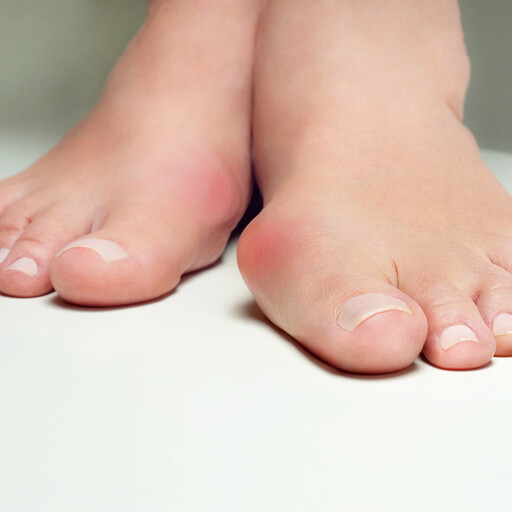Bunions
Even though bunions are a common foot deformity, there are misconceptions about them. Many people may unnecessarily suffer the pain of bunions for years before seeking treatment.
What is a Bunion?
A bunion (also referred to as Hallux Valgus or Hallux Abducto Valgus) is often described as a bump on the side of the big toe. But a bunion is more than that. The visible bump actually reflects changes in the bony framework of the front part of the foot. The big toe leans toward the second toe, rather than pointing straight ahead. This throws the bones out of alignment – producing the bunion’s “bump.”
Signs & Symptoms
Symptoms, which occur at the site of the bunion, may include:
Pain or soreness
Inflammation and redness
A burning sensation
Possible numbness
Symptoms occur most often when wearing shoes that crowd the toes, such as shoes with a tight toe box or high heels. This may explain why women are more likely to have symptoms than men. In addition, spending long periods of time on your feet can aggravate the symptoms of bunions.
Causes
The formation of a bunion is progressive and caused by a number of factors that affect the normal function of the foot. These include but are not limited to:
the shape of the big toe joint,
the length of the 1st Metatarsal shaft,
the direction and strength of pull from the muscles and tendons that move the big toe and those that help control the foot,
the shape of the Subtalar Joint and its direction of and extend of movement, just to mention a few.
It is generally accepted within the medical fraternity that Bunions are inherited, so if your predecessors have them, it’s more likely you will have them too. They begin with a leaning of the big toe, gradually changing the angle of the bones over the years and slowly producing the characteristic bump, which becomes increasingly prominent. Symptoms may appear at later stages.
Although wearing shoes that crowd the toes won’t actually cause bunions, it sometimes makes the deformity get progressively worse. Symptoms may therefore appear sooner.
Diagnosis
Bunions are readily apparent – the prominence is visible at the base of the big toe or side of the foot. However, to fully evaluate the condition, the podiatrist may organise X-rays to determine the degree of the deformity and assess the changes that have occurred.
Because bunions are progressive, they don’t go away, and will usually get worse over time. But not all cases are alike – some bunions progress more rapidly than others. Once our podiatrist has evaluated your bunion, a treatment plan can be developed that is suited to your needs.
Treatment
If a bunion interferes with daily activities, it’s time to discuss your treatment options. Despite claims to the contrary, the only way you can cure, fix, reposition a Bunion deformity is surgical correction. This involves surgically cutting through the misaligned portions of bone and surgically repositioning and fixing them into a correct “anatomically reduced” position.
However it is important to note that surgical intervention is only recommended when the bunion causes pain, irritation with footwear, infection and when all non-surgical treatments have failed or considered unlikely to help reduce your symptoms.
Our podiatrist will help explain the range of non-surgical treatments that may reduce your symptoms and improve your quality of life.
These may include:
Orthotics: Prescription orthotics and Pre-fabricated orthotics
Footwear advice
Footwear modifications
Strengthening exercises
Prevention
It is generally accepted within the medical fraternity that Bunions are inherited, so if your predecessors have them, it’s more likely you will have them too. Although wearing shoes that crowd the toes won’t actually cause bunions, it sometimes makes the deformity get progressively worse so choosing foot-shaped, round-toed footwear that doesn’t push on your toes is recommended.
Unfortunately for most of us who have a genetic predisposition to Bunion formation, they are an inevitability, despite what the adverts say, if you’re going to get them there isn’t much one can do to avoid them. Early treatment is recommended.

